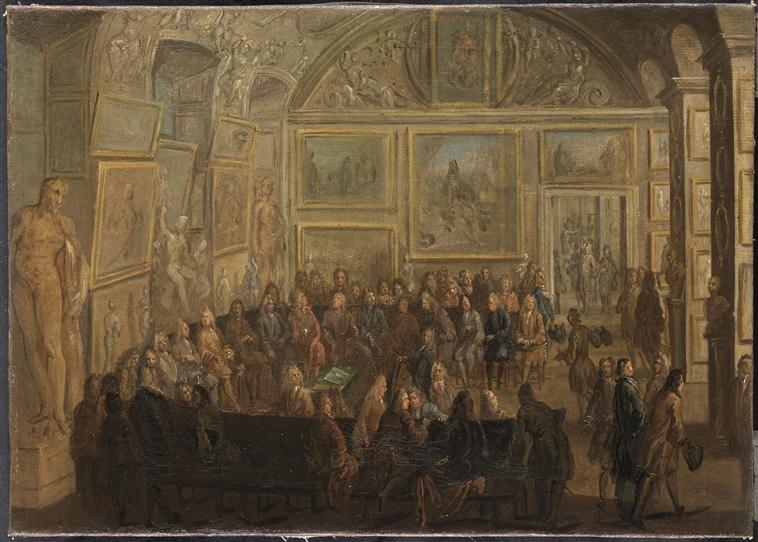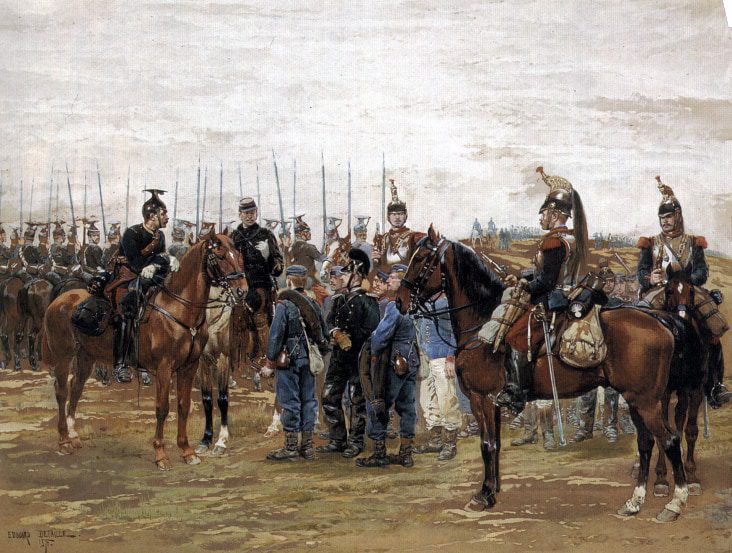All about the life and works of Edouard Detaille

Jean Baptiste Édouard Detaille (1848–1912), French painter. Photo from Wikimédia Commons.
Who is Edouard Detaille?
What is the “Salon” of Paris?

An ordinary meeting of the Royal Academy of Painting and Sculpture at the Louvre- by Jean Baptiste Martin. Photo from Wikimédia Commons.
Many artists were revealed there, but many people critisized the elitist nature of the event. As a result of this criticism, Napoleon III authorized in 1863 that the refused artists be exhibited in a specific “Salon des Refusés”.
Other exhibitions were organized after this opening, such as impressionist exhibitions and the “Salon des indépendants” . It had a significant impact on French art. Those events contributed to the end of academic monopoly. Indeed, it allowed artists to diversify their work.
What is the Franco-Prussian War?
The war between France and the Kingdom of Prussia (and its German allies) was brief but had dramatic consequences for both nations and for Europe as a whole.
The French felt humiliated and the victorious Germans arrogant. Those two feelings were at the root of the two great world conflicts of the 20th century: the First and Second World Wars. The two countries had previously felt sympathy for each other. This conflict made them ennemies.

A French Cavalry Officer Guarding Captured Bavarian Soldiers. By Edouard Detaille. Photo from Wikimédia commons
The tragedy confronted the German Chancellor Otto von Bismarck and Emperor Napoleon III. Bismarck was a man of war and a fine strategist whose life was dedicated to enlarge the Prussian kingdom. Napoleon III was seriously weakened by the disease.
At that time the French army was weak and not ready to wage war, while the Prussian army was large, modern and well trained.
The causes of the War of 1870 were based on a political coup by Chancellor Bismarck. It happened in the context of the succession to the Crown of Spain in 1868. Bismarck suggested the candidacy of Prince Leopold of Hohenzollern-Sigmaringen, cousin of the King of Prussia, to head the Kingdom of Spain.
It leaded to Emperor Napoleon III’s exasperation towards Prussia. Indeed, the proposal implied subjecting France to a situation of encirclement and thus forcing the country to considerably limit its political pressure against Prussian operations.
Napoleon III asked for two things : the withdrawal of this candidacy and the guarantee that no other Prussian prince would ever claim the Spanish throne again.
He decited to send the French ambassador, Vincent Benedetti, to negociate with the King of Prussia. During their meeting, the king confirmed his approval of the Prince’s Leopold withdrawal from the Spanish succession but courteously refused to commit himself further.
The situation seemed to have calmed down.
But Bismarck absolutely wanted to go to war with France, which he knew was weak. He decided to provide a modified report of the interview between the King of Prussia and the French ambassador. The report, suggesting a humiliating dismissal of the ambassador, provoked public outrage in Paris.
The emperor declared war on July 19, 1870.
Six weeks of terrible wars followed for the Napoleonic Empire and leaded to its fall. On January 18, 1871, the victors proclaimed the German Empire in the Galerie des Glaces at Versailles. They then walked through the bereaved and silent capital on March 1, 1871.
The Paris siege
Did you know that the city of Paris had been under siege for 5 months?

Military life at French fort, “Bastion” during the Siege of Paris, 1870 – Photo from Wikimédia Commons.
The Franco-Prussian conflict is at the origin of this major event in the city’s history. It happened during the winter of 1870 (from 19 September 1870-28 January 1871). The Prussian armies reached Paris after Sedan’s defeat and the capture of Napoleon III. A terrible siege began, which ended with the armistice of 28 January 1871.
Nearly two million people were trapped for five months of winter, leading to a major famine. The rationing of foodstuffs was complicated and the queues in front of the shops were becoming very long. Prices of meat, preserves, bread and foodstuffs were soaring.
Communications with the outside world were completely cut off, and meat soon became scarce. The bourgeoisie began to slaughter horses, which until then had only been consumed by the poor.
A rat market was organized on the square of the Town Hall for the most deprived. On December 25, 1970, Parisians with more means could eat in the luxury restaurants meals with donkey, elephant, camel, kangaroo, bear, wolf or antelope, which were none other than the animals of the Jardin des Plantes.
During this siege, the mortality rate doubled in a few months, especially following lung diseases due to cold and malnutrition.
“Le rêve” of Edouard Detaille
Edouard Detaille remains mainly in posterity through his painting in 1888 entitled “Le Rêve”.
The painting testifies to the patriotic and vengeful state of mind that reigned in France after the humiliating defeat of the Franco-German War of 1870. The year following the publication of the painting, mandatory military service was introduced on 15 July 1889 for all young citizens.
What can you see in the painting?

“Le rêve” from Edouard Detaille. By Edouard Detaille. Photo from Wikimédia commons.
On a wide plain, soldiers bivouac, enjoying last minutes of rest while on the horizon the sun begins to rise. Everything seems calm and peaceful. But in the sky, mixed with the clouds, the dream of these soldiers is taking shape.
You can see triumphant figures, silhouettes and flags that tell of a victorious battle. The dream of these soldiers is none other than the one of a nation still wounded by the failure of 1870.
The soldiers depicted on the painting are the young recruits from the Third Republic who hope to take their revenge. They dream of their predecessors and the great victories of the Napoleonic army.
The painting became a great success. Édouard Detaille obtained a medal of honour at the “Salon de la Société des artistes français” in 1888 and the painting was acquired by the State in the same year. It was exhibited at the Universal Exhibition in 1889. Since 1986 he has been assigned to the Musée d’Orsay.
The political significance of the painting persisted for decades after its publication and was reused in postcards to spread heroic and patriotic values during the First World War.
Detaille travelled extensively in Europe and painted foreign armies, but his favorite theme remained the second empire and the heroic figure of Napoleon.

“Vive l’empereur”, painting intended for the glory of Napoleon- Photo from Wikimédia Commons.
Great painter of military history, many of his works are now known throughout the world. He died in Paris in 1912.
You now know everything about Edouard Detaille work and about Paris history at that time. I hope you’ve enjoyed reading this article. Don’t hesitate to contact us if you need further information about anything!
Planning a trip to Paris ? Get ready !
These are Amazon’s best-selling travel products that you may need for coming to Paris.
Bookstore
- The best travel book : Rick Steves – Paris 2023 – Learn more here
- Fodor’s Paris 2024 – Learn more here
Travel Gear
- Venture Pal Lightweight Backpack – Learn more here
- Samsonite Winfield 2 28″ Luggage – Learn more here
- Swig Savvy’s Stainless Steel Insulated Water Bottle – Learn more here
Check Amazon’s best-seller list for the most popular travel accessories. We sometimes read this list just to find out what new travel products people are buying.









